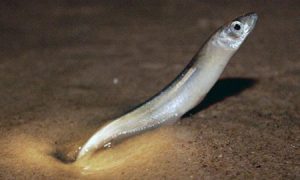
Isn’t reproduction a remarkable thing? I’m aware that this statement makes me sound like I’ve just discovered it. In a way that’s true. I’d better explain.
A couple of years ago, my old schoolfriend Brian, who now lives in New York, proposed that I feature the word grunion – a sardine-like fish that inhabits the coastal waters of that American appendage they call Baja California. Brian’s argument for grunion being his ‘mot du jour’, as he put it, was that it rhymed with onion and bunion.
This sort of revelation is hugely valuable to poets and songwriters and if you want the proof, here it is. If you’re pushed for time, fast forward to 1’25”. It’s early Frank Zappa, in 1963, singing How’s Your Bird and it features the unusual rhyming couplet: ‘How’s your bunion? An’ how’s your grunion?’ They literally do not write them like that any more.
There are two varieties of grunion: the California grunion, which lives off the Pacific coast of Baja California, and the Gulf grunion, which lives on the other side of the appendage, in the Gulf of California. This is the only part of the world you’ll find them. Grunion don’t travel much.
But who needs to travel when you mate like a grunion? Here’s what they do. Between the months of March and August, the females take advantage of high tides to beach themselves in huge numbers. They then burrow their tails into the sand, lay their eggs and wait for some male attention.
It arrives with a vengeance. The males come riding in on the waves, each one looking like a young Keanu Reeves in Point Break, and wriggle around among the mass of writhing bodies until they find a female to latch onto. They then wrap themselves around her and, without so much as a box of Milk Tray, deposit their milt (that’s a word you can look up yourselves) so that it runs down her body and fertilises the eggs under the sand. And you thought Valentine’s Day was complicated!
They all then catch another wave and return to the sea, leaving the eggs to mature in the sand until the tide rises again about 10 days later and causes the eggs to hatch. They don’t just do this once a season, by the way. The females will go through the ritual as many as six times each year. Insatiable!
So thanks to Brian for opening my eyes to this particular natural nugget, but there was something in his original message that made me uneasy – like an excess cushion on a sofa that just hinders you from feeling completely relaxed. He didn’t just point out that grunion rhymes with onion and bunion, he went one further (too far, if you ask me) and added “those hoop corn crisps, Funyuns”.
Whoa! Whoa! Whoa! Funyuns? That has an ‘s’ on the end. Grunion does not. Not even if you’re talking about more than one grunion. You’ll notice Zappa asked, “How’s your bunion?”, not, “How are your bunions?” Bunions nearly always come in twos, but he was smart enough to spot that if he wanted it to rhyme with grunion, he would have to keep his bunion singular.
For a grunion is a fish and the plural of fish is – all together now – fish. You don’t say fishes. Or, for that matter, turbots, or plaices, haddocks or trouts. OK, so sharks are an exception, but who’s brave enough to tell them otherwise?
For some reason we tend not to pluralise animals, especially the ones we have a habit of shooting: buffalo, rhino, lion, pheasant, deer, moose… Maybe it makes us feel better to keep the numbers down.
Not something you’d say about the grunion.


